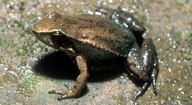|
Hyloxalus idiomelus (Rivero, 1991)
| family: Dendrobatidae subfamily: Hyloxalinae genus: Hyloxalus |
 © 2004 Natural History Museum and Biodiversity Research Center, The University of Kansas (1 of 3) |
|
|
|
Description A tadpole in Stage 34 has a body length of 14.2 mm and a total length of 34.7 mm. Free-swimming tadpoles in Stage 25 may be as small as 8.4 mm in body length and 16.9 mm in total length, whereas tadpoles in Stage 43 may have a body length of 16.3 mm and a total length of 36.6 mm. The body is wider than high; the snout is bluntly rounded in dorsal view and slopes anteroventrally from the level of the orbits to a rounded tip in profile. The small eyes are situated dorsally, directed dorsolaterally, and not visible from below. The spiracle is sinistral with a short tube attached to the body for its entire length; the spiracular opening is directed posterodorsally just below the midline at about midlength of body. The cloacal tube is short, dextral, and attached to the ventral fin. The caudal musculature is moderately robust, approximately uniform in depth on the anterior one-third of the tail, and gradually diminishes distally to a pointed tip. The dorsal fin originates on the base of the caudal musculature, gradually increases in height on the proximal two-thirds of the tail, and then declines to an acutely rounded tip. The ventral fin originates on the body wall and is highest at midlength of the tail. The oral disc is directed anteroventrally. Deep lateral folds are present, and the median half of the anterior labium is bare; elsewhere the labia bear a single irregular row of small, subconical marginal papillae. The jaw sheaths are thin and finely serrate; the anterior sheath is in the form of a broad arch, and the posterior sheath is broadly V-shaped. The labial tooth row formula is 2/3; all rows of teeth are about equal in length, In life, the body is olive brown; the belly is creamy gray, and the tail is tan with olive flecks and brown spots or reticulations. Recently metamorphosed young with SVLs of 10.8–14.1 mm have the incipient color pattern of the adults. Distribution and Habitat Country distribution from AmphibiaWeb's database: Peru
Life History, Abundance, Activity, and Special Behaviors
References
Duellman, W. E. (2004). ''Frogs of the genus Colostethus (Anura; Dendrobatidae) in the Andes of northern Peru.'' Scientific Papers of the Natural History Museum, University of Kansas, 35, 1-49. Rivero, J. A. (1991). ''New Colostethus (Amphibia, Dendrobatidae) from South America.'' Breviora, 493, 1-28. Originally submitted by: William Duellman (first posted 2004-12-10) Edited by: Kellie Whittaker (2007-12-03) Species Account Citation: AmphibiaWeb 2007 Hyloxalus idiomelus <https://amphibiaweb.org/species/1569> University of California, Berkeley, CA, USA. Accessed Nov 14, 2024.
Feedback or comments about this page.
Citation: AmphibiaWeb. 2024. <https://amphibiaweb.org> University of California, Berkeley, CA, USA. Accessed 14 Nov 2024. AmphibiaWeb's policy on data use. |


 Map of Life
Map of Life